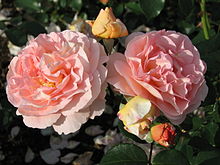Europa rosarium
Coordinates: 51 ° 28 ′ 30.6 " N , 11 ° 18 ′ 53.3" E
The Europa-Rosarium in Sangerhausen ( Saxony-Anhalt ) has the largest rose collection in the world. Today more than 8600 rose species and rose varieties, over 57 rose classes - a total of around 80,000 rose bushes are planted on an area of 13 hectares . These include around 500 different species and forms of wild roses . The rosarium is operated by the GRF Foundation Europa-Rosarium Sangerhausen.
History of the rosarium
The Sangerhausen Rosarium was initially intended by the Association of German Rose Friends (VDR) as a collection point for newly introduced rose varieties. Peter Lambert - rose grower from Trier and founding member of the VDR - proposed in 1897 to create a club rosarium. The rose collector Albert Hoffmann donated his collection of around 1,100 rose varieties as the basis for the rosarium. In 1899 the garden architect Friedrich Erich Doerr designed a formal rose garden, which was expanded to include an agricultural section in 1902. After five years, the Sangerhausen Rosarium was opened to the public on an area of 1.5 hectares on July 3, 1903 for the Congress of German Rose Friends.
The wild rose collection of the botanist Georg Dieck from Zöschen with 450 varieties of roses was exhibited at the 1900 World Exhibition in Paris. In 1909 his collection was added to the Sangerhausen Rosarium. In 1927 the first novelty test of rose varieties took place in Sangerhausen. In 1933, the co-founder and, from his retirement in 1922, honorary manager Ewald Gnau , known as the rose professor , officially resigned from his activities in protest against the Gleichschaltungsgesetz . In 1955 a plaque was placed in his honor on the boulder erected in the Alpinum . In 1939 the Rosarium, then with 5,000 rose varieties, was expanded to an area of 12.5 hectares.
In 1947, young plants and the library of the VDR were sent to Moscow , Leningrad and Kiev in the USSR as reparations for the construction of rosaries . In 1964 an ideas competition for the reorganization and expansion of the rosarium was organized. According to the design proposals, the show garden was laid out on the extension site in 1969. Since 1977 the “Festival of 1000 Lights” has been celebrated as a rose festival with fireworks and large park illumination. In 1987 a part of the garden with 150 varieties of roses was redesigned on an area of about one hectare, which is dedicated to rose breeding in the German Democratic Republic (GDR). 3000 rose plants give an overview of 40 years of rose growing in the GDR.
In 1993 the Sangerhausen Rosarium was named the European Rosarium and Sangerhausen the Rose City of the VDR. On the occasion of the 100th birthday, a new entrance area, a restaurant and three new gardens (anniversary garden , sea of roses and ADR garden ) were opened in 2003 . The Sangerhauser Jubiläumsrose ( Kordes ) rose variety was christened by the Prime Minister of Saxony-Anhalt, Wolfgang Böhmer , in the Jubilee Garden. In the same year, the Rosarium was also recognized by the World Federation of Rose Societies as an Excellent Garden (Award of Garden Excellence) .
In order to finance the operation of the rosarium and thus to ensure its continued existence, the “VDR-Stiftung Europa-Rosarium Sangerhausen” (today's name “GRF-Stiftung Europa-Rosarium Sangerhausen”) was founded.
In recent years the rosarium has been expanded to include a rose information center, a glass house and a scented garden. Since 2006 the Rosarium has also been marketed for tourism by the Network Garden Dreams Saxony-Anhalt .
Main focus of the rose collection
Although the collection was preserved and expanded throughout the Third Reich and beyond the end of the war in 1945, the Rosarium no longer served its original purpose during the GDR and only acquired a few new items between 1950 and 1990. In the meantime, however, the collection has been expanded through acquisitions.
The collection is a living encyclopedia and extensive collection of rose varieties, especially those of the early 20th century. The main focus is on polyantha roses , remontant roses, noisette roses and rambler roses , many of which are also rarities. The rosarium also contains a collection of rose varieties from former communist countries.
Location of the rosarium
The rose garden is located in a cold region with temperatures down to −25 ° C ( USDA zone 5b ) at 200 meters above sea level with a rainfall of 500 millimeters per year. The soil is sandy and shallow with a neutral pH value .
gallery
literature
- Hella Brumme : Europa-Rosarium - A guide through the Sangerhausen Rosarium. Verlag Janos Stekovics, Dößel 2010, ISBN 978-3-89923-080-2 .
- Charles & Brigid Quest-Ritson: Roses: The Great Encyclopedia. The Royal Horticultural Society; Translation by Susanne Bonn; Editor: Agnes Pahler. Dorling Kindersley, Starnberg 2004, ISBN 3-8310-0590-7 , p. 354.
- Klaus-Jürgen Strobel: Everything about roses. Ulmer, Stuttgart 2006, ISBN 3-8001-4471-9 , p. 94.
Web links
Individual evidence
- ↑ Ronald Clark: Garden Travel Guide . Georg DW Callwey, 2008, p. 608 .
- ^ Award of Garden Excellence. (No longer available online.) World Federation of Rose Societies, November 2012, archived from the original on July 27, 2014 ; accessed on August 11, 2014 . Info: The archive link was inserted automatically and has not yet been checked. Please check the original and archive link according to the instructions and then remove this notice.
- ↑ a b History and development of the Europa Rosarium. Europa-Rosarium, accessed August 12, 2014 .










